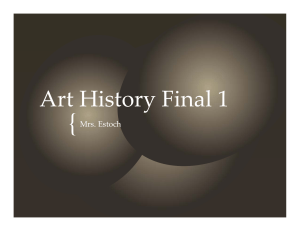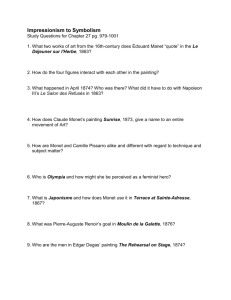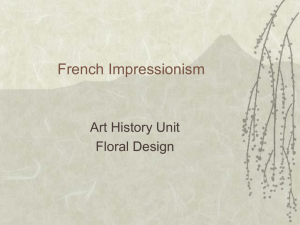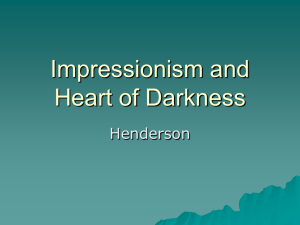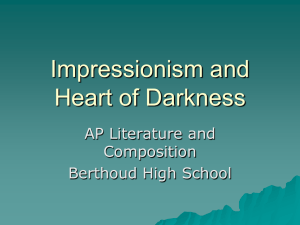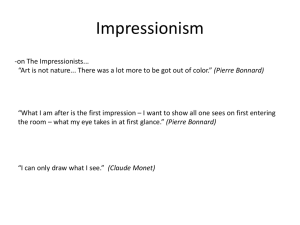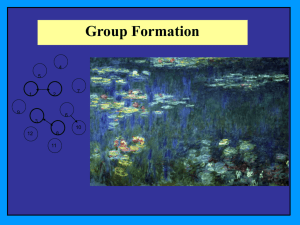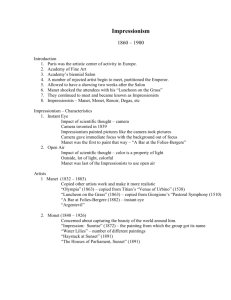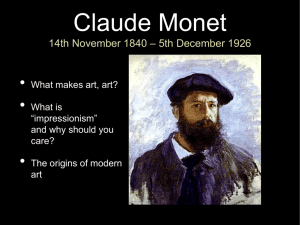Document 10984394
advertisement
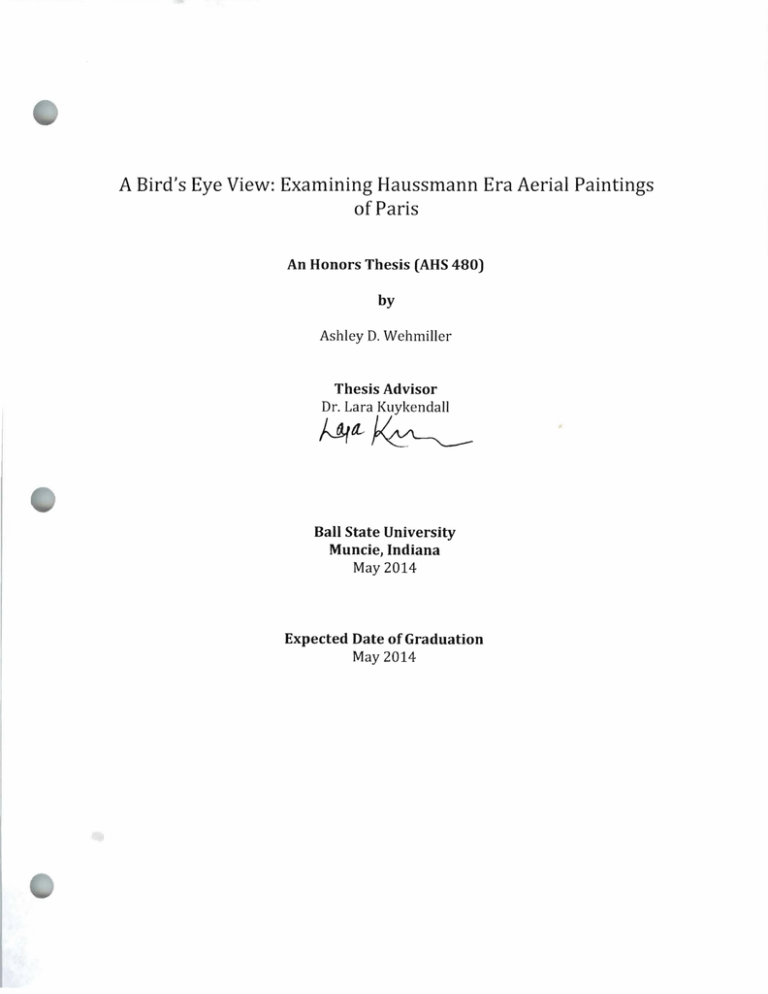
A Bird's Eye View: Examining Haussmann Era Aerial Paintings of Paris An Honors Thesis (AHS 480) by Ashley D. Wehmiller Thesis Advisor Dr. Lara Kuykendall MtL~ Ball State University Muncie, Indiana May 2014 Expected Date of Graduation May 2014 SpeO)) Und er3 rod -rhe=:>is. L.:v ~LJ~ o; ABSTRACT tJ1Jj . WL)Lj Baron Haussmann was named Prefect of the Seine Department in France by Napoleon III in 1853, and he began transforming Paris into a modern city. He created parks for recreation and large public squares and markets, lined streets with gas street lights to make the city more pedestrian friendly, and implemented an architectural model that gave Paris a unified look. His transformation of the city literally changed the map. As city workers were mapping out the new city, artists were also looking down upon the new areas of Paris and recording what they saw. By looking at aerial paintings from the mid and late 19 th century, this thesis explores the effects of the modernized city on the population of Paris. Paintings by Claude Monet, Pierre-Auguste Renoir, Edouard Manet, and Gustave Caillebotte demonstrate how each artist's personal viewpoints informed their images of the Parisian urban landscape. ACKNOWLEDGMENTS I would like to thank my advisor, Dr. Lara Kuykendall, for her eagerness and willingness to advise me on my thesis topic. Her commitment and enthusiasm throughout our countless meetings motivated me to complete the project, resulting in a work of which I am very proud. Her art historical expertise, thought-provoking questions, and care greatly assisted me throughout the duration of working on my thesis. She is always supportive and encouraging of all possible future endeavors of which I may pursue. 2 INTRODUCTION In 1867 Claude Monet visited the Louvre as a young artist with his portable easel and paint box in hand. Rather than studying and meticulously copying the Old Masters' works that lined the walls, he set up his easel on the second floor of the Louvre's East Colonnade overlooking the Seine's Left Bank below. From this vantage point, Monet painted three urban landscapes of Paris after Baron Haussmann's renovations created new boulevards, quays, and parks, opening up the city. In Garden of the Princess, Louvre (Figure 1) the second of the three landscapes, Monet literally turned his back to the hallowed museum and its contents, choosing the city-its people and buildings-as his subject matter.l Aerial views of the city would prove to be an important and recurring subject for Monet and his fellow Impressionists, including Pierre-Auguste Renoir, Edouard Manet and Gustave Caillebotte, following the Haussmannization of Paris. All of the citizens of Paris navigated the new aspects of the city and became acquainted with the new boulevards, quays, and gardens. Impressionists portrayed visual, political, psychological, and social aspects of Parisian life against the backdrop of the Haussmannization of the city. Baron Georges- Eugene Haussmann was named Prefect of the Seine Department in France by Napoleon III in 1853, and his vision transformed Paris into a modern city until his dismissal in 1870. Haussmann in large part carried on with the renovation plans started by Napoleon Bonaparte in 1804, which continued with little progress during Louis-Philippe's time in power in the 1830s and 1840s. Part of James H. Rubin, Impressionism and the Modern Landscape (Los Angeles: University of California Press, 2008), 28. 1 3 the renovation of the city included demolishing narrow medieval streets and buildings for new wide, tree-lined boulevards and widening and extending existing boulevards to improve traffic flow. Along the Seine, eight new bridges were erected and quays were widened to open up the river to traffic. He also created parks for recreation and large public squares and markets, lined streets with gas lights to make the city more pedestrian friendly, and implemented an architectural model that gave Paris a unified look. Motivations for the modernization of the city were not only to improve traffic flow and visual aspects of the city, but also to combat disease, political uprisings, and overcrowded neighborhoods. His transformation of the city literally changed the map. Towers were built all over the city for workers to survey and map the changing landscape. As city workers were mapping out the new city, artists were beginning to look down upon the new areas of Paris and record what they saw. From the beginning of the renovation through the end of the nineteenth century, artists and photographers found elevated positions across the city in studios, apartments, cafes, and museums to look down upon the quays, boulevards, and vistas. They photographed and painted Parisians utilizing the new spaces. The transformation of the city greatly affected the everyday lives of the citizens of Paris, from improving traffic flow to bettering living and health conditions by fixing the sewage problems. Haussmann breathed life into the city because of the light and air brought in to Paris. Impressionist painters used aerial views of Paris from the Haussmannization era as mechanisms for expressing their artistic, social, and political values. Claude Monet and Pierre-August Renoir took to raised vantage 4 points to paint generalized views of Parisian boulevards, parks, and squares as bustling centers of urban life. Their emphasis was on technique, presenting distant views of the city. Renoir evaded representing political and social issues in his paintings, while Monet presented the issues plaguing Paris at the time in subtle ways. Edouard Manet, on the other hand, painted carefully constructed narratives that deliberately exposed political and social issues facing France during the 1860s and 1870s. Gustave Caillebotte painted elevated views of the city as a means of expressing gender issues and exposing the psychological anxiety associated with the new urban landscape. At first glance, the images discussed in the paper have similar visual qualities, but upon examining the paintings of the Parisian urban landscape, Monet, Renoir, Manet, and Caillebotte's personal viewpoints become clear because of the imagery represented in their oeuvres. MONET AND RENOIR: THE THOUGHTFUL OBSERVERS The year 1867 marked an important time for Paris. The modern city was on display as visitors from all over came to the city for the Universal Exposition. Monet, Renoir, and Manet painted the city during the Exposition, but Manet used the fair and new urban landscape as a setting for exposing political and social issues, while Monet and Renoir took an apolitical observational approach to their paintings. The vertical aerial painting of 1867, Garden a/the Princess, Louvre (Figure 1) encompasses many of the new aspects of the city during Haussmannization. In the foreground, Monet separated the lush green grass surrounded by manicured flowerbeds of the Louvre's garden from the new elements of Paris by a gold fence. 5 Beyond the serene garden, opening up to the left is a vista created in 1854. 2 These areas were possible because of the demolition of old buildings, meant to open up views of important Parisian landmarks. Nearly hidden, flowing in between the trees is the Seine. Past the Seine are views of the Left Bank, its skyline marked by notable landmarks such as the Pantheon that lies directly on the centerline of the painting. 3 Monet's bright use of colors in the foreground and the expansive sky, taking up over one third of the canvas, emphasize the light and open atmosphere Haussmann brought into the capital. Medieval buildings some fifteen years prior to the painting's completion in 1867 would have obscured the skyline in Garden o/the Princess. As a stamp of approval of the Haussmannization of Paris, Monet includes the French flag, prominent in the center right of the composition. As James Rubin writes, Hit seems no accident that the French flag waves proudly on a tall pole on the quay in the middle of the ground. The new Paris was a matter of national pride, and Monet's picture declares a new genre of painting to celebrate it."4 Further suggesting Parisians' and Monet's approval of the city is the concentration of action in the painting. In the new square and along the quay are masses of citizens and tourists, moving about for leisure and purpose. Monet employs an impressionistic technique, though it is not as fully developed as in his later paintings, where his use of loose brushwork blurs figures and lines. His development of the Impressionist technique suggests movement and heightens the Rubin, Impressionism and the Modern Landscape, 28. 3 Robert L. Herbert, Impressionism: Art, Leisure, and Parisian Society (New Haven: Yale University Press, 1988), 10. 4 Rubin, Impressionism and the Modern Landscape, 30. 2 6 feeling that viewers are looking at a captured moment. 5 This image is representative of a transitional time in Monet's career. Here he gives equal attention to the Louvre's garden and traditional monuments in the skyline as to the newly created vista and quay. Monet found excitement in the movement and fleeting moment associated with the new urban landscape. 6 He balanced his enthusiasm with accurate depictions of the geographic elements of the scene below. Along with Garden of the Princess, the other two aerial paintings Monet painted from the second story window of the Louvre combine old monumental Paris with the new modern areas created by the Haussmannization of the city. The first completed in the series, Quai du Louvre (Figure 2) was painted in 1866 when the artist was only 26 years old. The composition does not have a single focal point, but with multiple focal points the viewer's eye moves through the work, just as the strollers move along the quay. The quay was created during the Haussmannization of Paris, and is situated just beyond the Louvre's garden of the Princess. Beyond the Seine, dividing the old and new Paris, the Pont Neuf connects the Ile de la Cite to the quay, which was newly widened during the renovation of the city. Monet portrayed pedestrians and cabs moving along the quay emphasizing the Impressionist motif, a fleeting moment, during the passing of a sunny, spring day in Paris? Monet draws upon similarities between old and new Paris in the similar domed shapes of the historic dome of the Pantheon in the skyline and the cylindrical kiosk on the quay, introduced by Haussmann. Similarly, Monet uses equestrian imagery to show Rubin, Impressionism and the Modern Landscape, 47. 6 Herbert, Impressionism: Art, Leisure, and Parisian Society, 10. 7 Pierre Courthion, Paris in Our Time (Paris: S.P.A.D.E.M., 1957), 10. 5 7 similarities between the old equestrian statue of Henry IV on the lIe de la Cite and the horses pulling carriages in the foreground. 8 In Sainte-Germain I'Auxerrois, Paris (Figure 3), Monet again joined history and modernity by his inclusion of the church, a modern apartment building, and the vista in the foreground. The dominating gothic church with its rose window and flying buttresses in the background represents old Paris. Tradition meets modernity when one of the new apartment buildings introduced by Haussmann recesses into the composition seemingly merging with the gothic church. In the foreground is one of the new urban vistas meant to open up the area between the Louvre and Saint Germain L'Auxerrois to pedestrians of all social statuses. 9 Monet renders those pedestrians as a crowd promenading around the square. Overall, Monet's three paintings show the artist painting the areas below him as lively hubs for the people of Paris to enjoy against the backdrop of old and new Paris. Paris is rendered in a style that also merges old with new. His early paintings included clarity and detail not found in his later works. As Monet's career progressed, his brushwork became more loose and impressionistic. Throughout his aerial paintings, Monet's views are distant and maintain a neutrality that Manet and CaiIIebotte's images do not possess. Pierre-Auguste Renoir's early paintings are similar to Monet's in their clarity and avoidance of political and social issues. Renoir depicted the gardens of the Champs- Elysees in the painting, The Champs-Elysees during the Paris Fair of1867 (Figure 4). In 1864 Napoleon III declared the World's Fair of 1867 would be held in John House, Impressionism: Paint and Politics (New Haven: Yale University Press, 2004), 107. 9 Rubin, Impressionism and the Modern Landscape, 28. 8 8 Paris, allowing three years for Haussmann and his workers to complete as many boulevards, quays, and vistas as possible before the fair's opening in April. In the foreground of The Champs-Elysees during the Paris Fair are some thirty pedestrians all neatly dressed walking along the paths and sitting on the ground. Some stroll in pairs while others meander alone. The use of the garden was only been for leisure purposes of the upper classes. Trees, shrubbery, lawns, and hints of the surrounding city in the distance dominate Renoir's wide panoramic painting. The Palais de I'Industrie from the 1855 fair stands beyond the trees and the Cafe des Ambassadeurs is at the right edge of the composition. The Cafe des Alnbassadeurs was a popular cafe-concert often frequented by the upper classes beginning in the 1860s, emphasizing the bourgeois theme Renoir's paintings often take. Working and lower class Parisians did not partake in viewing cafe-concerts or strolling along the park of the Cham ps-Elysees. Renoir only included one working class person, a gardener attending to a newly planted garden. 10 He is the only person in the painting in the act of doing any activity other than walking or sitting. Renoir shied away from overt expressions of class distinctions. The gardener's appearance in the painting is a matter of observation; he is not in contrast to the other people but is simply part of the reality of what Renoir saw. If Renoir wanted the gardener to expose social distinctions in Paris during the Second Empire, he would have made him a focal point to the painting, but here the gardener blends into the scene, and becomes part of the urban landscape as a whole. 10 Herbert, Impressionism: Art, Leisure, and Parisian Society, 6. 9 Along the Seine, strips of buildings were demolished to provide space for quays that opened up the area along the river to horse drawn carriages and pedestrian traffic. For a decade beginning in 1852, eight new bridges were erected and others rebuilt enabling better traffic flow across the river.ll One bridge to receive attention from multiple Impressionist artists was the Pont Neuf, located in the city's busy center. The bridge was cleared to improve both vehicular and pedestrian traffic during the Haussmannization of Paris. Monet and Renoir painted views of the bridge connecting the Left Bank with the lIe de la Cite in 1871 and 1872, respectively. These paintings while still depicting changes in the city are more focused on the movement along the bridge with the city as the backdrop.12 Painting from a second story cafe window, the artists had a clear aerial vantage point of the Left Bank, however the atmospheres of the paintings are quite different. Monet's Le Pont Neuf(Figure 5) portrays a sketchy view of the bridge during a rainy day, as strollers take refuge from the rain under their umbrellas. Pierre Courthion notes that the painting "evokes the nostalgic charm of a wet day in Paris."13 Atmosphere and weather, both important in Impressionist works, contribute to the mood of the painting. Pedestrians walk in isolation, not interacting with one another along the bridge. The somber tone and lack of interaction could represent the sentiments of Parisians after the Franco-Prussian War. The war lasted from July 19 th , 1870 to May 20 th , 1871, and resulted in loss of over 138,000 French lives and the rise of the bloody French Commune, the insurrection of Paris against 11 Herbert, Impressionism: Art, Leisure, and Parisian Society, 3. 12 Rubin, Impressionism and the Modern Landscape, 51. 13 Courthion, Paris in Our Time, 15. 10 the French government killing 20,000 insurrectionists during what was known as the bloody week. In this painting, distinctions among social classes are not clear because of the sketchy quality and similar tones throughout. The muted colors and shielded pedestrians against the rain represent a united and "humiliated nation ... recovering their poise and returning to responsibilities with sobriety and determination."14 The pedestrian traffic and displays of industry such as the inclusion of the steamboat in the Seine suggest the sense of responsibility and a return to normalcy.ls Monet does not overtly tackle the loss of life and political sentiments in the year of 1871, but uses weather and tone to suggest the somber state of France. Unlike Monet's painting that shows the return to normalcy under somber and rainy circumstances, Renoir's image is sunny and cheerful. In Le Pont Neuf (Figure 6) Renoir painted vendors, bourgeOisie, soldiers, and other Parisians strolling in harmony in an urban environment. Renoir's image evokes movement; one can imagine the puffy white clouds moving across the sky as the shadows of pedestrians follow the figures along the bridge. In the scene, other Parisians stop to peer out at boats along the Seine. In fact, Renoir sent his brother Edmond out into the space to stroll about and engage with pedestrians to slow down the movement so he could sketch the scene more fully. This is evident by his presence twice in the Paul Hayes Tucker, Claude Monet: Life and Art (New Haven: Yale University Press, 1995),50. IS Rubin, Impressionism and the Modern Landscape 51. 14 J 11 painting, identified by his straw hat.1 6 Possibly part of Renoir's motivation in emphasizing interaction is to show the Ilreturn to normalcy in the public sphere the year following the savage suppression of the Commune."17 Renoir's approached representing the return to normalcy after the Franco-Prussian War and the Commune in a very different way from Monet's Le Pont Neufimage. Renoir portrayed Paris as a sunny, bustling city. Men, women, and children are enjoying the city and seem completely unaffected by the previous war. Renoir provided an escapist view and completely ignored the destruction and loss of life that affected the city less than a year ago. As the renovation continued, hundreds of miles of streets were altered, widened, and connected with new ones, including the boulevard des Capucines, which Monet depicted in two paintings (Figures 7 and 8) in 1873. That year Monet and other artists took over the second story studio of photographer Nadar, which would later become the place for the Impressionists' first exhibition. Monet's working space was situated at the corner of the boulevard des Capucines and the rue Daunou, and looked out at the Place de l'Opera, the Grand Hotel, and the Theatre de Vaudeville. 18 Boulevard des Capucines was one of the Grand Boulevards that became the major commercial channels of the city after the Haussmannization of Paris. The commercial nature of the avenue is evident in the cargo wagons, private 16 Nancy Forgione, flEveryday Life in Motion: The Art of Walking in Late-Nineteenth­ Century Paris," The Art Bulletin 87, no. 4 (December 2005): 666-667. 17 Albert Boime, Art and the French Commune (Princeton: Princeton University Press, 1995),117. 18 Herbert, Impressionism: Art, Leisure, and Parisian Society, 18. 12 carriages, shoppers, and vendors Monet rendered along the street. 19 Making the street even more accessible to the masses was the Gare Saint-Lazare nearby that offered transportation for suburbanites to enter the city and walk the boulevard, mixing with the bourgeoisie and city dwellers.20 The boulevard was so highly trafficked it was reported that in the same year of the paintings creation over 23,000 horses walked along the street daily. Monet's paintings disregard certain negative aspects of the modernized boulevard, such as the dust and smell from the thousands of horses, but he did hint at a possible negative facet of the easily traversed boulevards: the unruly mob. In the years following the revolution, minor civil wars and revolts plagued France, and many Parisians, government officials and citizens alike, feared the possibility of more uprisings. Particularly in the Pushkin Museum's painting (Figure 8), the pedestrians along the sidewalk begin to blend and blur the further back in the composition they appear. By the 1870s Monet's style had become increasingly Impressionistic, with loose brushwork and more atmospheric effects. The mass of people appear as a large group; gone are the isolated pedestrians and clear depictions of Parisians from the earlier paintings. Albert Boime considers the mass of people to be reminiscent of the mobs of the recently attempted rebellion during the Commune. He states, "the anonymous brush gestures may be faceless and stripped of their individual objectivity, but this was true also of the ghosts of the recently crushed rebellion threatening at any time to be reincarnated in the floating mass of people."21 19 Rubin, Impressionism and the Modern Landscape, 6. 20 Herbert, Impressionism: Art, Leisure, and Parisian Society, 18. 21 Boime, Art and the French Commune, 37. 13 Although Boime equates the mass of people with an unruly mob, other art historians see the mass of people blending together to suggest movement and the act of strolling along the boulevard. 22 Monet also takes artistic liberty, widening and flattening the avenue. His deemphasis on the typically deep receding lines created by the boulevards in photographs suggests Monet had a different purpose than to record a topographical representation of the surroundings. Monet focused on the act of looking and observation, made 0 bvious because of his inclusion of two top-hatted men peering down at the street from a balcony along on the right edge of the paintings. These men occupy the second floor apartment, indicated by the proximity of the awnings below. At the time the largest and most luxurious apartments were located on the second and third floors of the new Haussmann apartment buildings.23 The attire and position of the men suggest they are flaneurs. A flaneur was an upper-class male who spent his time leisurely strolling and idling about Paris. Instead of anonymously wandering the city, the men on the balcony have positioned themselves above the crowd, conversing and viewing the activity of the people below. Emphasis is on the act of looking and observing, not only for the artist but for the men as well, a theme of Impressionism and modernity as a whole. 24 The men in the balcony are sure to partake in the activity of the street below every day-they intermingle, sometimes walking for purpose and other times walking to observe. Although no longer part of 22 Rubin, Impressionism and the Modern Landscape 108. 23 Rubin, Impressionism and the Modern Landscape 30. 24 Rubin, Impressionism and the Modern Landscape 31. J J J 14 the street's activity, their hand gestures and downward glance show they are still participating in the scene, but from above. 25 In contrast to Monet's Boulevard des Capucines, The Rue Montorgueil in Paris, Celebration o/June 30, 1878 (Figure 9) and Rue Saint-Dennis, Celebration o/June 30, 1878 (Figure 10) are of working class streets untouched by the Haussmannization of Paris. Monet recorded moments of celebration during the first national holiday set by the Third Republic. The festival celebrated the return to normalcy after the Franco- Prussian War and the beginning of the first Universal Exposition since the Commune. 26 Just a year prior, however, government leaders threatened to return France to a monarchy, heavily opposed by most French people and France had lost many of its colonies, leaving the country in financial jeopardy. At first glance, the paintings appear jubilant with a sense of renewal and optimism, but after examining the scenes a subtle political theme emerges. In Rue Saint-Denis and The Rue Montorgueil, Boime notes, Monet "is hardly politically neutral since he only gives the illusion of unity. Here we see quite clearly that the idea of Impression, with its emphasis on the fleeting moment, perfectly suited the selective thought processes necessary to sustaining the illusion."27 Monet's lack of attention to individuals and his distant view of the street create a sense of false unity in the celebration the presumable working class group is partaking in. Monet was never one to make overt political statenlents in his work, 25 Herbert, Impressionism: Art Leisure, and Parisian Society, 19. 26 James H. Rubin, Impressionism (London: Phaidon Press Limited, 1999), 277. 27 Boime, Art and the French Commune, 137. 15 however viewers at the time would be aware of the working class's sentiments towards the Republic, as they opposed any possibility of a return to monarchial rule. Monet never makes his political statements obvious, rather he only hints at political issues, allowing the view to draw their own conclusions, seen again in his Tuileries series of 1867. Monet painted the images of the Tuileries Gardens from the window of art collector, Victor Choquet's home on the rue de Rivoli. 28 The Tuileries (Figure 11) dually represents the leisure activity of strolling through the park and the previous government, the Commune's destruction. During the Commune, the Communards burned the palace in 1871, where the ruins remained until their destruction in 1883. The ruined palace is relegated to the background of the scene and is not prominent. In the far right background of the picture is the fac;ade of another ruined public building, the Cour des Comptes. 29 Monet only included signs of the Commune in the far edges of the paintings because he did not want the memories of hardship to be central to the painting. He pays more attention to the lush gardens around the area, taking up the majority of the composition. Along the paths are Parisians continuing on with their daily lives promenading in the recently reopened garden. Monet makes memories of destruction IIblend harmoniously with his image of restoration and regeneration."30 He draws upon positive memories of the previous government, when Louis-Napoleon opened the park to pedestrians, and minimizes the most recent use of the garden for artillery storage during the Herbert, Impressionism: ArtJ LeisureJ and Parisian Society, 142. House, Impressionism: Paint and PoliticsJ 108-109. 30 Boime, Art and the French Commune, 173. 28 29 16 Commune. 31 The painting is an observation of casual leisure and of the French people continuing their lives, but also serves as a memory and lesson of the past. 32 MANET: EXPOSING POLITICAL AND SOCIAL INJUSTICES Painted commemorating the World's Fair of 1867, Edouard Manet's View of the Paris World's Fair (Figure 12), differs from Monet and Renoir's paintings of the same year (Figures 1 through 4). Manet comments on social and political issues in his painting, where as technique and the modern landscape were the emphasis for Monet and Renoir. Manet rendered the historical buildings, the dome of the Invalides and the Pantheon, with little detail, while the twin towers of the Universal Exposition and other modern structures are painted precisely. Industry and invention are represented in the puffs of smoke rising from the fairground's steam works. Past the hill, Manet paints the National Panorama, devoted to changing displays of military prowess. The dome of the military academy and the National Panorama expose the irony of the location of the exposition dedicated to peace. 33 Beyond pointing out the political ironies of the World's Fair, Manet also carefully arranged the figures in the painting to represent Parisian society in 1867. Along the path and in the grass, the full spectrum of Parisian society in 1867 is represented. The working class includes the groundskeeper, the two lower class women with their backs turned to the viewer, and the two children playing in the Boime, Art and the French Commune, 68. 32 House, Impressionism: Paint and Politics, 110. 33 Beth Brombert, Edouard Manet: Rebel in a Frock Coat (Canada: Little, Brown, and Company, 1996), 205. 31 17 grass. Two upper class women are strolling along the path} while another pair of well-dressed men gaze out across the skyline. Near the two men are three military persons} two are standing and one is seated. An amazone} or a woman riding a horse without a male escort appears in the center of the path.34 The painting juxtaposes the working classes and the upper classes. In the bottom left of the composition} the gardener is watering the flowerbeds} unlike in Renoir}s Champs-Elysees painting where the gardener is standing with a toot but is not in the act of working. The two children playing in the grass appear uncivilized next to the young well-dressed boy walking his dog. Additionally the working class pair of women is standing looking out over the buildings of the World}s Fair} while the bourgeois women seem uninterested and stroll along the path. Finally} the military men are not shown working} but are relaxing on the grass. Robert Herbert notes} lithe more we look into this picture the more apparent is its order} despite his spirit of confrontation} Manet gives his composition something of the implacable regularity of Napoleon}s and Haussmann}s scheme of things.JJ35 Manet appears to have carefully composed the composition to display the ironies of politics and society in Paris. Manet illustrates that while people of different social statuses inhabit areas of the modern city} they do not interact and are still defined by their wealth and standing in society. As Manefs career progressed} he continued to paint images sympathetic to the working class and war veterans} evident in his Rue Mosnier paintings. Prior to the June 30 th celebration of 1878} Manet painted Street PaversJ Rue Mosnier (Figure 34 Herbert} Impressionism: ArtJ LeisureJ and Parisian Society} 5. 35 Herbert} Impressionism: ArtJ LeisureJ and Parisian Society} 5. 18 13) from his studio. The green of the trees and the laboring street pavers in the lower register of the painting indicate the springtime completion of the painting. The street workers were feverously working to complete the city's renovations before the national holiday and arrival of the Universal Exposition. 36 Manet's scenes differ greatly from the other Impressionists, because he does not record a fleeting moment, but he carefully constructs scenes that convey messages about modern life. Street Pavers is a record of the constant metamorphosis of the city as he experienced it. 37 The street his studio faced in fact did not exist a few years prior. It was built along the rail yards in the 1870s, and was still being completed in the painting. 38 Manet's record of urban construction shows how pedestrians interacted with the city's changes. As the pavers complete the street, pedestrians and carriages travel past them. The well-dressed men in horse drawn carriages pay no attention to the working pavers. Manet draws the attention to the lack of concern for the working class's plight in the painting. The upper class seems unconcerned with the possibility of disrupting the paver's ability to complete their job. Manet looked upon streets with a different kind of reputation than the luxurious Grands Boulevards. Even though it had only recently been constructed, rue Mosnier already had a reputation as a seedy street. In Zola's novel Nana, rue Mosnier is described as, Ita quiet new street in the quartier de l'Europe, no shop fronts, but fine houses, with narrow little apartments inhabited by ladies, It was five 0' clock; along the deserted sidewalks, in the aristocratic peace of the tall white Francoise Cachin and Charles S. Moffett, Manet: 1832-1883 (New York: Harry N. Abrams, Inc., 1983), 397. 37 Herbert, Impressionism: Art, Leisure, and Parisian Society, 30. 38 Rubin, Impressionism and the Modern Landscape, 277. 36 19 houses, stockbrokers' and n1erchants' coupes stood by, \vhile Inen walked quickly, raising their eyes to the windows where WOlnen in peignoirs seemed to vvait. Nana refused at first to go Up."39 The street's reputation is possibly confirmed by the inclusion of two \vomen in Manet's other painting of rue Mosnier from that saIne year. The Rue Mosnier with Flags (Figure 14) shows a street decked out for the national holiday, with France's flags hanging from the buildings lining the street. Although the flags indicate a celebration, Manet's imagery contrasts to the celebratory emblems of the Republic. Hobbling along the ne\vly constructed street in the lower left of the painting is a one-legged man with crutches. He is presumably a veteran of the Franco-Prussian War in 1870. His blue shirt indicates he is a laborer, and until 1878 when they were incorporated into the festivities of the Universal Exposition, he and other veterans were forgotten heroes, lost in history.40 Manet not only comments of the effects of the war, but in James Rubin's Impressionism, he suggests, //Manet's sornber note questioned the charade of unity" of the Republic and he saw //politics as a corrupt and cruel hoax."41 Manet strengthens his argument by juxtaposing the crippled figure and an unseen able-bodied man carrying a ladder at the bottom edge of the canvas. On the opposite side of the road are well-dressed men in top hats near a fashionable carriage. Two women leisurely walk near them along the sidewalk. They are possibly prostitutes, as the area around his studio had Cachin and Moffett, Manet: 1832-1883, 398. 40 Boime, Art and the French Commune, 138. 41 Rubin, Impressionism, 277. 39 20 a reputation for that activity.42 Manet exposes the hardships after war and critiques the government, creating a composite view of Parisian society through many observations from his studio and time walking the city. As stated, Rue Mosnier with Flags is not a purely observational image, but the painting is a composite of observations and sketches by the artist. The Metropolitan Museum of Art owns an India ink wash drawing on paper of a frontal view of the man on crutches in the painting (Figure 15).43 Manet, more than any other Impressionist, was concerned with the political and social injustices in Paris. Unlike other images of Monet and Renoir, he does not merely observe the action on the street below, but he makes poignant statements on modern Parisian life using the newly constructed rue Mosnier as his backdrop. CAILLEBOTTE: GENDER AND PSYCHOLOGICAL TENSIONS IN PARIS Caillebotte's Young Man at his Window (Figure 16) is an image of a flaneur­ type man looking down at a Parisian street. The painting marks the first time Caillebotte visited the theme of looking out at Paris, which becomes a popular motif for him in the late 1870s. In the work, a man looks out with an unknown expression onto the almost deserted street. The only action he sees other than a woman crossing the boulevard are a few horse drawn carriages. The interior is the bourgeois apartment of the artist's family is on the third floor, at the corner of the 42 House, Impressionism: Paint and Politics, 110-111. 43 Cachin and Moffett, Manet: 1832-1883, 398. 21 rue de Miromesnil and the rue de Lisbonne. 44 The area was built up about a decade previous to the paintings completion during the Haussmannization of Paris. Although the identity of Caillebotte's figure is known to be his brother Rene, his face remains unseen and we cannot see where his gaze is landing or with what expression. Based upon the angle of his head and the position of the woman as the central figure on the street, viewers assume he is looking at her. There is, however, a possibility he is looking at something outside the viewer's field of vision or he could be looking at nothing in particular. 45 Caillebotte, by uniquely including both an upper-class apartment interior and the isolated woman on the street below, dramatizes and exposes gender relationships in Paris at the time. The man's confident stance in the luxurious third story apartment solidifies his privileged social standing and along with that his privileged point ofview. 46 The woman is the assumed object of his gaze, and his powerful gaze contrasts strongly to her isolated and distant position, walking unaccompanied on the street below. As Boime states, "Rene possesses the outdoor, public space by virtue of his command over private property. Caillebotte expresses this superiority through the lofty vantage point that permits surveillance without being seen in return."47 Rene's superior social standing allowed him to have privileges that other lower class people and women did not possess. He resides in a space that allows him to view Paris and the people below without any notice. The 44 Anne Distel, Douglas W. Druick, Gloria Groom, and Rodolphe Rapetti, Gustave Caillebotte: Urban Impressionism (New York: Abbeville Press Publishers, 1995), 148. 45 House, Impressionism: Paint and Politics, 114. 46 Boime, Art and the French Commune, 89. 47 Boime, Art and the French Commune, 91. 22 sharp contrast between the dark interior and light exterior, as well as his solid immovable stance and her movement further contrast the positions of the two people in the painting. 48 The inclusion of the chair facing the street implies this is a typical activity for the young man, grounding the fact that he habitually uses his position, power, and height to watch the activity on the street below, becoming a sort of voyeur to unexpecting women below. Caillebotte's painting contrasts sharply with Monet's Boulevard des Capucines in the sheer number of occupants on the streets. The woman in the street is unaccompanied and almost entirely alone, whereas in Monet's paintings anonymity with in a crowd is the theme. The paintings become more distinct when closely studying the positions of the elevated figures in the works. In Boulevard des Capucines, at the far right of the composition two men lean out over a balcony, conversing and viewing the commotion below. They are participants of the activity of the fashionable avenue, integrated in to the scene. If any passerby was to look up at their balcony, they are visible. Only parts of the figure's bodies are in the compositions, and their stances do not denote any power. Monet does not emphasize power in his painting, but only through knowledge of their sex and social position is their power is revealed. Rene Caillebotte, on the other hand, is sheltered in his apartment and alone. His stance, with grounded feet and wide elbows, gives him power. Caillebotte emphasizes his power in his stance, and position outside the Michael Fried, "Caillebotte's Impressionism," Representations 66 (Spring 1999): 27. 48 23 activity of the street. He is not integrated or exposed, because he is in the interior of his dark apartment, separated by the stone balustrade unable to be detected. 49 After painting Young Man at his Window, Caillebotte continued to paint urban scenes of Paris becoming progressively more modern in his subject matter and compositions. Caillebotte painted some scenes of the city from the balcony of an apartment situated on the corner of rue Gluck and boulevard Haussmann. From the apartment, Boulevard Haussmann, Snow (Figure 17) while unfinished, captures the diffused light that is characteristic of snowy weather. so Caillebotte continues to divide the viewer from the scene below, making spaces of interior and exterior separate through including the iron railing of the balcony in the lower portion of the painting. Beyond that few pedestrians are seen along the normally busy street, because of the weather conditions. The psychological angst associated with isolation in a large bustling city is a popular motif in Caillebotte's paintings. In 1880, Caillebotte created two paintings of zoomed in aspects of the Haussmannization of Paris. In Caillebotte's A Traffic Island, Boulevard Haussmann (Figure 18), he eliminates the horizon line, defining the scene with simplified elements such as the oval of the traffic island and lines of the curbs. The scene was painted in the residential area directly below where Young Man at his Window was painted. We are looking at an ordinary traffic island, created purely for pedestrian convenience and traffic flow. s1 Anne Distel notes, lithe austerity of the composition and the severe constraints here in1posed on the kind of conventional description 49 50 51 Herbert, Impressionism: Art Leisure, and Parisian Society, 19. Distel, Druick, Groom, and Rapetti. Gustave Caillebotte: Urban Impressionism, 125. Rubin, Impressionism and the Modern Landscape, 50. 24 then deemed suitable for such subject matter contribute to the remarkable final result: an eerie evocation of urban emptiness without parallel in its time."52 The feeling of psychological remoteness is emphasized by the lack of pedestrians against the stark pavement of the traffic island and surrounding street. The few pedestrians that are seen are all secluded, separated in length and facing different directions. Their isolation is further emphasized by the lack of visibility of surrounding buildings. Caillebotte paints an even more extreme view of the city below him in Boulevard Seen from Above (Figure 19). He anchors the painting with the bench and grill around the tree. Only the tops of pedestrians' heads are seen, except for the man seated on the bench. There is a certain anonymity associated with the men in the painting, because so few of their bodies are visible. Again we see such a small zoon1ed in portion of the city, contributing to the feeling of isolation among many in the city. The extreme bird's eye view of the people below suggests a certain voyeurism because of the lack of delectability of the viewer in our high vantage point. 53 Caillebotte's images suggest the existence of isolation even while walking the new and busy streets during the late 1800s in Paris. He did not populate his scenes with masses of people like Renoir and Monet did, rather he chose to focus on a few pedestrians, depicting them alone in the squares and on the sidewalks of the city. 52 Distel, Druick, Groom, and Rapetti. Gustave Caillebotte: Urban 53 Rubin, Impressionism and the Modern Landscape~ 50. Impressionism~ 171. 25 CONCLUSION Impressionism has long been associated with light, air, and bourgeois subject matter. While the Impressionists were working in Paris, Baron Haussmann received a reputation for bringing light and air in to the city, making it a modern and appealing metropolis. All the artists discussed represented Haussmannized Paris in their paintings, but only the works of Monet and Renoir hold true to the typical definition of Impressionism. The early works by Monet and Renoir highlighted the new areas in the center of the city as places of leisure and commerce. Manet's paintings exposed the political and social issues facing the city. Caillebotte's painting, Young Man at his Window juxtaposed interior space with exterior space and revealed gender issues, while his zoomed in scenes of traffic islands express the psychological isolation felt in the city. The Haussmann Era was a revolutionary time for the city and for the artists that depicted the capital. They abandoned historical conventions. Observation became the means by which the artists created their masterpieces, and their elevated positions allowed them to study the city and the people who filled the streets, quays, and parks they chose to paint. Their paintings construct the realities of the social, political, and psychological status of the people in them, filtered through a bird's eye view. 26 List of Illustrations Figure 1: Claude Monet, Garden of the Princess, Louvre (Le Jardin de I'Infante), 1867. Allen Memorial Museum, Oberlin College. Figure 2: Claude Monet, Quai du Louvre, 1866. Municipal Museum, The Hague. Figure 3: Claude Monet, Saint-Germain l'Auxerrois, Paris, 1867. Nationalgalerie, Berlin. Figure 4: Pierre-Auguste Renoir, The Champs Elysees during the Paris Fair of 1867, 1867. Private Collection. Figure 5: Claude Monet, Le Pont Neuf, 1871. Dallas Museum of Art; The Wendy and Emery Reves Collection. Figure 6: Pierre-Auguste Renoir, Pont Neuf, Paris, 1872. National Gallery of Art, Washington D.C. Figure 7: Claude Monet, Boulevard des Capucines, 1873-1874. Nelson-Atkins Museum of Art, Kansas City, MO. Figure 8: Claude Monet, Le Boulevard des Capucines, 1873. Pushkin Museum of Fine Art, Moscow. Figure 9: Claude Monet, The rue Montorgueil, Celebration ofJune 30, 1878, 1878. Musee D'Orsay, Paris. Figure 10: Claude Monet, Rue Saint-Denis, Celebration ofJune 30, 1878, 1878. Musee des Beaux-Arts, Rouen. Figure 11: Claude Monet, The Tuileries, 1876. Musee Marmottan, Paris. Figure 12: Edouard Manet, The Exposition Universelle or View of the Paris World's Fair, 1867. Nasjonalgalleriet, Oslo, Norway. Figure 13: Edouard Manet, Street Pavers, Rue Mosnier, 1878. Private Collection. Figure 14: Edouard Manet, The Rue Mosnier with Flags, 1878. Getty Museum, Los Angeles. Figure 15: Edouard Manet, Man on Crutches, 1878. Metropolitan Museum of Art, New York. Figure 16: Gustave Caillebotte, Young Man at his Window, 1875. Private Collection. 27 Figure 17: Gustave Caillebotte, Boulevard Haussamnn, Snow, 1879-81. Private Collection. Figure 18: Gustave Caillebotte, A Traffic Island, Boulevard Haussmann, 1880. Private Collection. Figure 19: Gustave Caillebotte, Boulevard Seen from Above, 1880. Private Collection. 28 Bibliography Boime, Albert. Art and the French Commune. Princeton: Princeton University Press, 1995. Brombert, Beth Archer. Edouard Manet: Rebel in a Frock Coat, Canada: Little, Brown, and Company, 1996. Cachin, Francoise, and Charles S. Moffett. Manet: 1832-1883. New York: Harry N. Abrams, Inc., 1983. Courthion, Pierre. Paris in Our Time. Paris: S.P.A.D.E.M., 1957. DisteL Anne, Douglas W. Druick Gloria Groom, Rodolphe Rapetti. Gustave Caillebotte: Urban Impressionism. New York: Abbeville Press Publishers, 1995. Forgione, Nancy. "Everyday Life in Motion: The Art of Walking in Late-Nineteenth­ Century Paris." The Art Bulletin, 87, no. 4 (December 2005): 664-687. Fried, Michael. "Caillebotte's Impressionism." Representations, 66 (Spring 1999): l­ SI. Herbert, Robert L. Impressionism: Art Leisure, and Parisian Society. New Haven: Yale University Press, 1988. House, John. Impressionism: Paint and Politics. New Haven: Yale University Press, 2004. Rubin, James H,. Impressionism. London: Phaidon Press Limited, 1999. Rubin, James H,. Impressionism and the Modern Landscape. Los Angeles: University of California Press, 2008. Tucker, Paul Hayes. Claude Monet: Life and Art. New Haven: Yale University Press, 1995. 29
